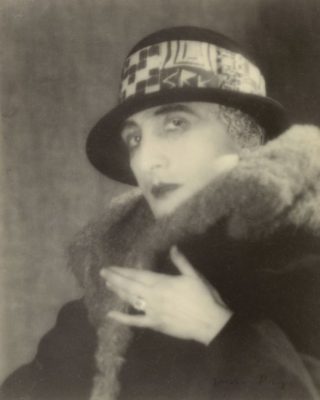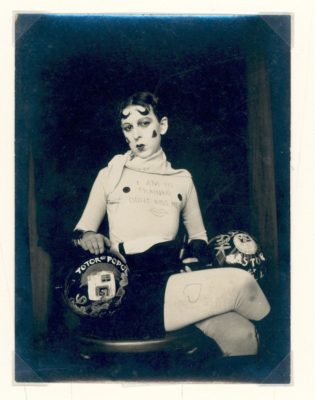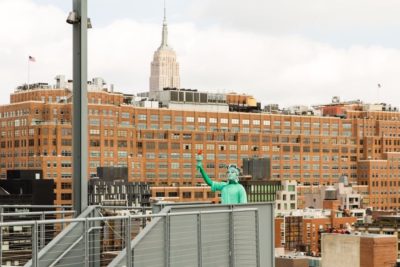
21 Sep A Brief History of Drag in the Art World
Drag has a rich cultural history, spanning cross-dressing performances and deliberate parodies of fixed roles of gender and sexuality. Men have been performing on stage as women since the Ancient Greek tragedies, Shakespeare famously cast men as women, and Baroque operas featured early examples of drag.
The term “drag queen” was first used to describe men appearing in women’s clothing in Polari—a type of British slang that was popularized among gay men and the theater community in the late 19th and 20th centuries. And while drag has long maintained a powerful presence in popular culture, more recently, it has developed a strong foothold in the art world as well.
Today, in the wake of the popular television program RuPaul’s Drag Race,drag queen Conchita Wurst winning the Eurovision Song Contest, and new drag-themed club nights popping up across London, New York, and L.A., one could say that drag is in the midst of having a mainstream moment. Riding this wave of popularity are art galleries and museums. Recently, drag has been identified as an influence among major art exhibitions, like the Whitney Biennial in New York, and performance programs, like “Contemporary Drag” at NADA New York this past March. It also serves as one of the themes in the new show “Queer British Art” at Tate Britain.


Artists have historically created work that might not be considered or intended to be “drag,” but nonetheless similarly challenge and deconstruct rigid social and sexual archetypes. Take, for example, Marcel Duchamp’s female alter ego Rrose Sélavy, who first appeared in 1920. The character’s name was a pun on “Eros, c’est la vie” (meaning “eros, it is life”) and she appeared in several portraits taken by photographer Man Ray. Sélavy was an expression of Duchamp’s love for subversion and enigma. Similarly, the artist Claude Cahun was the male alter ego of the Surrealist Lucie Schwob, who took self-portraits dressed in male garments.
Cahun was a forerunner to contemporary feminist artists like Lynn Hershman Leeson, Ana Mendieta, Cindy Sherman, and Gillian Wearing, among many others, who have played with elements of drag, often to critique the expectations placed on their gender. Hershman Leeson created a fictional character named Roberta Breitmore between 1973 and 1978, who even had her own therapist; Mendieta photographed herself with male facial hair to challenge gender signifiers; Sherman’s conceptual portraits have seen her disguise herself as fictionalized characters; and Wearing has manipulated her self image with masks.

Elsewhere in history, major artists have famously documented the practice of drag. Andy Warhol filmed drag queens like Candy Darling and Mario Montez. The video artist Charles Atlas filmed famous London nightlife star Leigh Bowery; photographer Nan Goldin captured drag queens in her hometown of Boston as a teenager, and New York’s drag communities in the 1980s and early ’90s; and later, Mario Montez collaborated with the photographer Conrad Ventur.
Atlas continues to work with drag, evidenced by his recent video, Here She Is…v1 (2015), which was included in MoMA PS1’s “Greater New York” exhibition in 2015. He featured the famous New York drag queen Lady Bunny lip syncing to camera. One could also argue that the colorful characters depicted in Ryan Trecartin’s works of the 2000s had a proto-Drag Race aesthetic about them.


Trecartin’s work was included in last year’s Berlin Biennale curated by the team behind DIS Magazine. The Biennale was titled “The Present in Drag,” and the DIS curators intended it to be a space for artists to reflect contemporary culture onto itself, rather than expose it. Also featured was the work of Amalia Ulman, whose self-portraiture sees her enact a fake character she has cultivated via social media.
The recent drag programming at NADA New York was focused on more traditional ideas of drag, influenced, in part, by the recent explosion of a new generation of drag queens in Brooklyn. “[We brought them] out of the bars and into the streets—or rather into the art fair,” says Sam Gordon, who co-curated the performance program with Jacob Robichaux (together they run Gordon Robichaux, a curatorial agency seeking to surface under-recognized artists).


That same Brooklyn drag scene was given gallery air-time at the end of last year in the show “Coney Island Babies: Visual Artists from the Brooklyn Drag Scene” at Bureau of General Service — Queer Division on West 13th Street in Manhattan. Curated by Director of the Fire Island Artist Residency Program, Chris Bogia, and drag performer and visual artist Montgomery Perry Smith, the show took stock of the vibrant community of contemporary visual artists in New York’s drag scene today. Prominent among the scene are the performance groups Chez Deep and Bushwig.
Meanwhile, across Europe, a renewed interest in drag has seen a slew of young artists incorporating it into their performance work. In the U.K., for example, Victoria Sin uses her drag persona to critique the expectation of feminine labor; and Samuel Douek, a drag performer, filmmaker, and artist who recently graduated from the Royal College of Art, has presented his work in both cabaret venues and galleries, as part of his work around queer spaces.
In Berlin, events on the city’s underground scene have recently been hosted by artists like Parker Tilghman, who enacts a drag persona as part of his work.


When asked why drag was a relevant subject choice for the NADA lineup this year, Gordon explained that within the current political climate, drag could address an urgent need. “Everyone really needed some drag right when we served it up,” Gordon told me, describing the events as joyous, defiant, and inspirational.
While emphasizing the contemporary moment, Gordon and Robichaux also acknowledged the evolving conversation around drag over time. Through a multigenerational group of drag artists—from the famous Lady Bunny and Tabboo! to younger performers like Sasha Velour, who has been hosting Nightgowns (a drag cabaret) in Bushwick for the last few years—they highlighted the deep history of drag’s presence in gallery spaces.
For example, artist Alexis Blair Penney was inspired to start the drag collective Chez Deep following a performance at MoMA PS1 in 2011 with Cody Critcheloe, Colin Self and Mykki Blanco. “If this is what a drag super-group looks like, I might just have to start one,” he thought. Penney noted that Chez Deep’s performance has run the full gamut of venues, from bars to white cube spaces. In 2014, the artist Spencer Sweeney flew them out to Glasgow to perform at The Modern Institute’s gallery space.

The main difference when you put drag performance in a gallery, Penney explained, is the crowd. “To be in a gallery setting where nobody is talking and they don’t even know if they should clap because they don’t want to interrupt things, it can be really intense,” he said. And in that sense, drag gets taken seriously by the art world, but Penney believes it’s still somewhat marginalized. “I think a lot of performance art still gets de-legitimized because its drag,” he said.
At this year’s Whitney Biennale though, drag—in some interpretation—has been given credence. Work relating to the practice is present across the show wrote co-curator Christopher Lew in the exhibition catalogue’s introductory essay. Collective Puppies Puppies, for example, presents Liberty (Liberté)(2016), what they’ve described as “a drag performance and sculpture,” where a performer dons a Statue of Liberty costume and stands in public. Lew pointed to works by Porpentine Charity Heartscape and Cauleen Smith, as well as Tommy Hartung’s video The Lesser Key of Solomon (2015), as all dealing with identity and emancipation, and in that sense speaking to the practice of drag. He cited these works as examples of how “in these recent times of escalating strife and partisanship, artists have taken it upon themselves to bridge divides.”

Gordon emphasizes that the current moment is just the latest iteration of drag. “Drag moves in cycles,” he says, “but it’s interesting to see how quickly the mainstream is finding the alternative.” If anything, he believes taking drag out of its traditional contexts and into the art world is helping it continue to evolve.
If one thinks about drag as the practice of performing gender, sexuality, or other fixed societal roles, then in a way, we’re all doing drag, all of the time. So long as it deconstructs identity categories, it’s still drag. And according to curators like Lew and Gordon, today, amid an oppressive political climate, it’s a more relevant means of expression and creativity than ever.
—Amelia Abraham
